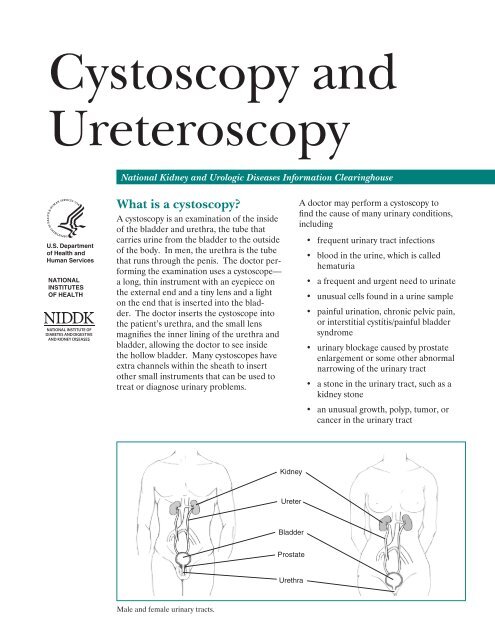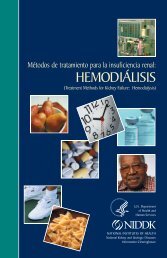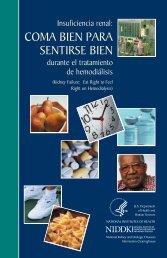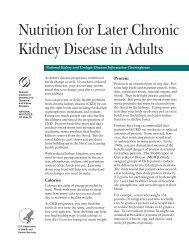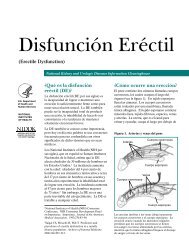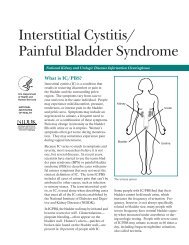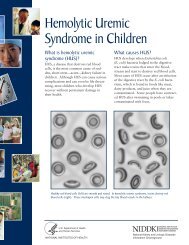Cystoscopy and Ureteroscopy - National Kidney and Urologic ...
Cystoscopy and Ureteroscopy - National Kidney and Urologic ...
Cystoscopy and Ureteroscopy - National Kidney and Urologic ...
Create successful ePaper yourself
Turn your PDF publications into a flip-book with our unique Google optimized e-Paper software.
<strong>Cystoscopy</strong> <strong>and</strong><br />
<strong>Ureteroscopy</strong><br />
U.S. Department<br />
of Health <strong>and</strong><br />
Human Services<br />
NATIONAL<br />
INSTITUTES<br />
OF HEALTH<br />
<strong>National</strong> <strong>Kidney</strong> <strong>and</strong> <strong>Urologic</strong> Diseases Information Clearinghouse<br />
What is a cystoscopy?<br />
A cystoscopy is an examination of the inside<br />
of the bladder <strong>and</strong> urethra, the tube that<br />
carries urine from the bladder to the outside<br />
of the body. In men, the urethra is the tube<br />
that runs through the penis. The doctor performing<br />
the examination uses a cystoscope—<br />
a long, thin instrument with an eyepiece on<br />
the external end <strong>and</strong> a tiny lens <strong>and</strong> a light<br />
on the end that is inserted into the bladder.<br />
The doctor inserts the cystoscope into<br />
the patient’s urethra, <strong>and</strong> the small lens<br />
magnifes the inner lining of the urethra <strong>and</strong><br />
bladder, allowing the doctor to see inside<br />
the hollow bladder. Many cystoscopes have<br />
extra channels within the sheath to insert<br />
other small instruments that can be used to<br />
treat or diagnose urinary problems.<br />
Male <strong>and</strong> female urinary tracts.<br />
<strong>Kidney</strong><br />
Ureter<br />
Bladder<br />
Prostate<br />
Urethra<br />
A doctor may perform a cystoscopy to<br />
fnd the cause of many urinary conditions,<br />
including<br />
• frequent urinary tract infections<br />
• blood in the urine, which is called<br />
hematuria<br />
• a frequent <strong>and</strong> urgent need to urinate<br />
• unusual cells found in a urine sample<br />
• painful urination, chronic pelvic pain,<br />
or interstitial cystitis/painful bladder<br />
syndrome<br />
• urinary blockage caused by prostate<br />
enlargement or some other abnormal<br />
narrowing of the urinary tract<br />
• a stone in the urinary tract, such as a<br />
kidney stone<br />
• an unusual growth, polyp, tumor, or<br />
cancer in the urinary tract
What is a ureteroscopy?<br />
A ureteroscopy is an examination or procedure<br />
using a ureteroscope. A ureteroscope,<br />
like a cystoscope, is an instrument<br />
for examining the inside of the urinary<br />
tract. A ureteroscope is longer <strong>and</strong> thinner<br />
than a cystoscope <strong>and</strong> is used to see beyond<br />
the bladder into the ureters, the tubes that<br />
carry urine from the kidneys to the bladder.<br />
Some ureteroscopes are fexible like a<br />
thin, long straw. Others are more rigid <strong>and</strong><br />
frm. Through the ureteroscope, the doctor<br />
can see a stone in the ureter <strong>and</strong> then<br />
remove it with a small basket at the end of a<br />
wire inserted through an extra channel in the<br />
ureteroscope. Another way to treat a stone<br />
through a ureteroscope is to extend a fexible<br />
fber through the scope up to the stone <strong>and</strong><br />
then, with a laser beam shone through the<br />
fber, break the stone into smaller pieces that<br />
can then pass out of the body in the urine.<br />
How <strong>and</strong> what the doctor will do is determined<br />
by the location, size, <strong>and</strong> composition<br />
of the stone.<br />
The reasons for a ureteroscopy include the<br />
following conditions:<br />
• frequent urinary tract infections<br />
• hematuria<br />
• unusual cells found in a urine sample<br />
• urinary blockage caused by an abnormal<br />
narrowing of the ureter<br />
• a kidney stone in the ureter<br />
• an unusual growth, polyp, tumor, or<br />
cancer in the ureter<br />
2 <strong>Cystoscopy</strong> <strong>and</strong> <strong>Ureteroscopy</strong><br />
What are the preparations<br />
for a cystoscopy or<br />
ureteroscopy?<br />
People scheduled for a cystoscopy or ureteroscopy<br />
should ask their doctor about any<br />
special instructions. In most cases, for cystoscopy,<br />
people will be able to eat normally<br />
in the hours before the test. For ureteroscopy,<br />
people may be told not to eat before<br />
the test.<br />
Rigid cystoscope (left) <strong>and</strong> semirigid ureteroscope<br />
(right).
Because any medical procedure has a small<br />
risk of injury, patients must sign a consent<br />
form before the test. They should not hesitate<br />
to ask their doctor about any concerns<br />
they might have.<br />
Patients may be asked to give a urine sample<br />
before the test to check for infection. They<br />
should avoid urinating for an hour before<br />
this part of the test.<br />
Usually, patients lie on their back with knees<br />
raised <strong>and</strong> apart. A nurse or technician<br />
cleans the area around the urethral opening<br />
<strong>and</strong> applies a local anesthetic so the patient<br />
will not experience any discomfort during the<br />
test.<br />
People having a ureteroscopy may receive<br />
a spinal or general anesthetic. They should<br />
arrange for a ride home after the test.<br />
3 <strong>Cystoscopy</strong> <strong>and</strong> <strong>Ureteroscopy</strong><br />
How is a cystoscopy or<br />
ureteroscopy performed?<br />
After a local anesthetic is used to take away<br />
sensation in the ureter, the doctor gently<br />
inserts the tip of the cystoscope or ureteroscope<br />
into the urethra <strong>and</strong> slowly glides it up<br />
into the bladder. A sterile liquid—water or<br />
salt water, called saline—fows through the<br />
scope to slowly fll the bladder <strong>and</strong> stretch it<br />
so the doctor has a better view of the bladder<br />
wall.<br />
As the bladder is flled with liquid, patients<br />
feel some discomfort <strong>and</strong> the urge to urinate.<br />
The doctor may then release some of the<br />
fuid, or the patient may empty the bladder<br />
as soon as the examination is over.<br />
The time from insertion of the scope to<br />
removal may be only a few minutes, or it<br />
may be longer if the doctor fnds a stone<br />
<strong>and</strong> decides to treat it. Taking a biopsy—a<br />
small tissue sample for examination with a<br />
microscope—will also make the procedure<br />
last longer. In most cases, the entire examination,<br />
including preparation, takes 15 to<br />
30 minutes.
What happens after a<br />
cystoscopy or ureteroscopy?<br />
Patients may have a mild burning feeling<br />
when they urinate, <strong>and</strong> they may see small<br />
amounts of blood in their urine. These<br />
problems should not last more than 24 hours.<br />
Patients should tell their doctor if bleeding<br />
or pain is severe or if problems last more<br />
than a day.<br />
To relieve discomfort, patients should drink<br />
two 8-ounce glasses of water each hour for<br />
2 hours after the procedure. They may ask<br />
their doctor if they can take a warm bath to<br />
relieve the burning feeling. If not, they may<br />
be able to hold a warm, damp washcloth over<br />
the urethral opening.<br />
The doctor may prescribe an antibiotic to<br />
take for 1 or 2 days to prevent an infection.<br />
Any signs of infection—including severe<br />
pain, chills, or fever—should be reported to<br />
a doctor.<br />
4 <strong>Cystoscopy</strong> <strong>and</strong> <strong>Ureteroscopy</strong><br />
Points to Remember<br />
• <strong>Cystoscopy</strong> <strong>and</strong> ureteroscopy are<br />
procedures used to view the inside<br />
of the bladder, urethra, <strong>and</strong> possibly<br />
the ureters.<br />
• A cystoscope is an instrument used<br />
to examine the urethra <strong>and</strong> bladder.<br />
• A ureteroscope is an instrument<br />
used to examine the ureters.<br />
• Before a cystoscopy or ureteroscopy,<br />
patients should<br />
– talk with their doctor to ask questions<br />
<strong>and</strong> receive instructions<br />
– sign a consent form<br />
– avoid urinating for about an hour<br />
before giving a urine sample if<br />
one is required<br />
– arrange for a ride home if general<br />
or spinal anesthetic will be<br />
used<br />
• After a cystoscopy or ureteroscopy,<br />
patients should<br />
– drink two 8-ounce glasses of<br />
water each hour for 2 hours<br />
– ask about taking a bath or using a<br />
warm, damp washcloth to relieve<br />
the burning feeling<br />
– report any problems, such as<br />
- bloody urine that lasts more<br />
than 24 hours after the test<br />
- severe pain<br />
- chills<br />
- fever
Hope through Research<br />
The <strong>National</strong> Institute of Diabetes <strong>and</strong><br />
Digestive <strong>and</strong> <strong>Kidney</strong> Diseases (NIDDK)<br />
has many research programs aimed at<br />
underst<strong>and</strong>ing kidney <strong>and</strong> urologic disorders,<br />
including urinary stones, enlarged prostate,<br />
urinary incontinence, <strong>and</strong> kidney failure.<br />
The NIDDK sponsors researchers developing<br />
advanced diagnostic equipment, such as<br />
cystoscopes that can examine bladder tissue<br />
at the microscopic level. This technology<br />
may in some cases eliminate the need for<br />
biopsy.<br />
Participants in clinical trials can play a more<br />
active role in their own health care, gain<br />
access to new research treatments before<br />
they are widely available, <strong>and</strong> help others by<br />
contributing to medical research. For information<br />
about current studies, visit<br />
www.ClinicalTrials.gov.<br />
For More Information<br />
American <strong>Urologic</strong>al Association Foundation<br />
1000 Corporate Boulevard<br />
Linthicum, MD 21090<br />
Phone: 1–866–RING–AUA (1–866–746–4282)<br />
or 410–689–3700<br />
Fax: 410–689–3800<br />
Email: auafoundation@auafoundation.org<br />
Internet: www.UrologyHealth.org<br />
Interstitial Cystitis Association<br />
110 North Washington Street, Suite 340<br />
Rockville, MD 20850<br />
Phone: 1–800–HELP–ICA (1–800–435–7422)<br />
or 301–610–5300<br />
Fax: 301–610–5308<br />
Email: icamail@ichelp.org<br />
Internet: www.ichelp.org<br />
5 <strong>Cystoscopy</strong> <strong>and</strong> <strong>Ureteroscopy</strong><br />
Acknowledgments<br />
Publications produced by the Clearinghouse<br />
are carefully reviewed by both NIDDK<br />
scientists <strong>and</strong> outside experts. This publication<br />
was originally reviewed by Michael B.<br />
Chancellor, M.D., University of Pittsburgh<br />
Medical Center, <strong>and</strong> William D. Steers,<br />
M.D., University of Virginia.<br />
You may also fnd additional information about this<br />
topic by visiting MedlinePlus at www.medlineplus.gov.<br />
This publication may contain information about<br />
medications. When prepared, this publication<br />
included the most current information available.<br />
For updates or for questions about any medications,<br />
contact the U.S. Food <strong>and</strong> Drug Administration<br />
toll-free at 1–888–INFO–FDA (1–888–463–6332)<br />
or visit www.fda.gov. Consult your doctor for more<br />
information.
<strong>National</strong> <strong>Kidney</strong> <strong>and</strong><br />
<strong>Urologic</strong> Diseases<br />
Information Clearinghouse<br />
3 Information Way<br />
Bethesda, MD 20892–3580<br />
Phone: 1–800–891–5390<br />
TTY: 1–866–569–1162<br />
Fax: 703–738–4929<br />
Email: nkudic@info.niddk.nih.gov<br />
Internet: www.kidney.niddk.nih.gov<br />
The <strong>National</strong> <strong>Kidney</strong> <strong>and</strong> <strong>Urologic</strong> Diseases<br />
Information Clearinghouse (NKUDIC)<br />
is a service of the <strong>National</strong> Institute of<br />
Diabetes <strong>and</strong> Digestive <strong>and</strong> <strong>Kidney</strong> Diseases<br />
(NIDDK). The NIDDK is part of the<br />
<strong>National</strong> Institutes of Health of the U.S.<br />
Department of Health <strong>and</strong> Human Services.<br />
Established in 1987, the Clearinghouse<br />
provides information about diseases of the<br />
kidneys <strong>and</strong> urologic system to people with<br />
kidney <strong>and</strong> urologic disorders <strong>and</strong> to their<br />
families, health care professionals, <strong>and</strong> the<br />
public. The NKUDIC answers inquiries,<br />
develops <strong>and</strong> distributes publications, <strong>and</strong><br />
works closely with professional <strong>and</strong> patient<br />
organizations <strong>and</strong> Government agencies<br />
to coordinate resources about kidney <strong>and</strong><br />
urologic diseases.<br />
This publication is not copyrighted. The Clearinghouse<br />
encourages users of this publication to duplicate <strong>and</strong><br />
distribute as many copies as desired.<br />
This publication is available at<br />
www.kidney.niddk.nih.gov.<br />
U.S. DEPARTMENT OF HEALTH<br />
AND HUMAN SERVICES<br />
<strong>National</strong> Institutes of Health<br />
NIH Publication No. 09–4800<br />
August 2009


